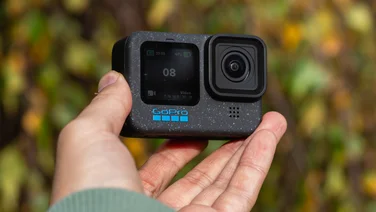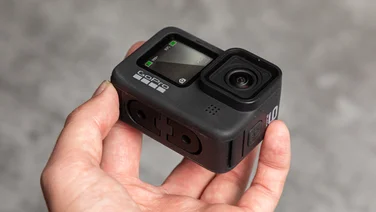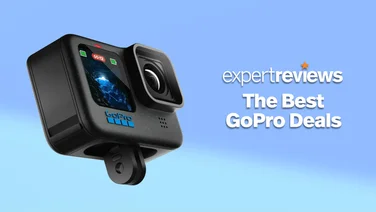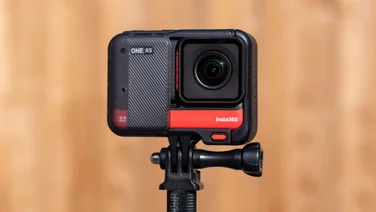To help us provide you with free impartial advice, we may earn a commission if you buy through links on our site. Learn more



















- Incredibly flexible
- Great image quality
- Easy to use
- Bulkier than a regular GoPro
- Can’t shoot in 4K
I’ve tested a few 360-degree cameras in the past and, although they’ve been fun to use, I’ve never really seen the point. With clunky software, few ways of reliably sharing footage and generally poor image quality, the 360 cameras I’ve used have, so far, been mere novelties. The GoPro Hero Max changes all that.
This is a camera that takes the technology to places it has never been before. It’s the best I’ve used and, in fact, it’s the first 360-degree camera I’d consider recommending to anyone. It gets everything right, from hardware through to the all-important software and editing features. It’s an unbelievably good camera.
READ NEXT: DJI Osmo Action review – a real challenger to GoPro
GoPro Hero Max review: What you need to know
To look at, you’d be forgiven for wondering what the fuss is all about. After all, it doesn’t look fundamentally different to any other 360 camera on the market today, including GoPro’s own Fusion 360 camera.
It has two fisheye lenses, each one mounted opposite the other, either side of a blocky body, which also features a small colour touch screen. These can be used to record video and photos that capture your entire surroundings. You can usually interact with these by swiping and pinching to navigate around the scene.
GoPro Max review: Price and competition
At £480, the GoPro Max is not what you could call an impulse purchase. It’s £100 more expensive than a regular GoPro Hero 8 Black, which is capable of kicking out higher resolution regular video than the Max.
The main competition for the GoPro Max comes from the Insta360 One X, a camera the Max owes more than a passing resemblance to in the way it works, if not the way it looks. With the One X, Insta360 pioneered the concept of simple app-based keystone-based reframing, a method the Max also uses to make 360-degree filming more practical.
The Insta360 One X doesn’t have the full-colour touchscreen display of the GoPro and it can’t match the audio options of the Max, either. However, the One X is significantly cheaper to buy at £405 currently and has the ability to capture HDR video where the Max does not.
GoPro Max review: Design
As with a regular GoPro, all footage is recorded to a removable microSD card, located beneath a flap on the camera’s right edge. The whole thing is reasonably compact.
It’s considerably taller than a regular action camera and heavier, too, but it’s solidly built, waterproof to five metres and comes with a pair of plastic clip-on caps to protect the protruding lenses when it’s not in use.
This is no ordinary 360 camera, however. It can also be used, at the tap of a button, as a regular GoPro action camera and comes complete with a small colour touchscreen so vloggers can ensure narrow angle shots are framed correctly.



















Not only that, but a pair of fold-out fingers, attached to the base of the camera, allow you to use the Max with a host of GoPro-style accessories and mounts. Already own a GoPro? Chances are you have a tripod, selfie stick or or helmet mount stuffed away in a drawer somewhere that the Max will fit on.
Even if you don’t own any accessories, there’s no need to worry, as these are cheap and easy to come by on sites such as Amazon, eBay and AliExpress.



















GoPro Hero Max review: How it works
The clever stuff, however, all happens in the GoPro app, which pulls in 360-degree video over a Wi-Fi connection, stitches it together on the fly and lets you create clips you can actually use and share with friends.
Select a video you’ve captured in 360 mode (there are others, which I’ll get onto further down this review), tap to edit it and you’re straight into Reframe mode, which is where all the magic happens.
In this mode, you’re the director: point the camera at the action you want to focus on by swiping or pinching in/out, tap the timeline to set the camera position then advance the playback to the next thing you want to focus on, and repeat until you get to the end of the clip.

By default, the virtual camera pans from one point to the next smoothly but it’s also possible to adjust the transitions, either by adding more key frames or by using jump cuts, or “easing” into and out of key positions in your film.
It takes a bit of getting used to but after a few minutes of experimenting you’ll totally get what makes 360 video cameras so compelling. And, once you’re done, you can render out your reframed footage at 1080p.
The joy of this process is you don’t have to think about where to point the camera. Just press record and worry about where to direct the virtual camera later in the edit.
In fact, the only thing you really have to think about is how to mount the thing. The Max works best mounted on the end of a stick; if you hold your hand too close to the bottom of the camera, the stitching can look a little odd.
GoPro Max review: Features and other modes
But wait, there’s more. Not only is this a brilliant 360 camera, it’s also a 360 action camera, which means it benefits from a lot of the technology that GoPro has previously developed for use in its Hero Black series of cameras.
There’s HyperSmooth stabilisation, which GoPro says is the smoothest, steadiest stabilisation it has ever put on a camera. It has Horizon levelling, which detects the orientation of the camera and keeps your footage dead level, even if you spin the camera around in the air. And, unlike the Hero 8 Black, it does this in-camera. That’s an incredible feat of software engineering so perhaps understandable that it’s only available in “Hero” (i.e., single lens) mode and not at maximum resolution.



















Talking of resolution, this is not a camera you can shoot regular 4K video on, as you can with the GoPro Hero 8 Black. The Max captures 360 video at a total spherical resolution of 5.6K at 30fps – in fact, it captures at an impressive 6K, which ends up being 5.6K once the two video streams have been stitched together. And in “Hero” action camera mode it shoots up to 1440p resolution at 60fps. It’s worth noting, though, that this is at an odd 4:3 aspect ratio; if you and a more normal resolution, you’re stuck with regular 1080p.
That’s not all. The camera also has six microphones so it can record either “spherical audio”, stereo or shotgun directional audio, depending on which mode you find yourself in and which lens you’re using. The results here are pretty darned impressive.
Elsewhere, the Max can shoot 16-megapixel 360 stills, 5-megapixel regular shots and “power-pano” images, where the camera captures a 270-degree shot in an instant, without having to move the camera left to right or vertically.
Finally, the camera can also be used to produce incredibly cool 360-degree timelapse videos using GoPro’s stabilised TimeWarp mode. This isn’t automatic like it is on the Hero 8 Black – you have to choose the speed yourself, which requires a little planning in advance.
However, once you’ve captured your footage, you can edit it in exactly the same way via the Reframe tool as regular 360 footage, dragging the camera viewpoint around, dropping in key frames and rendering out 1080p video for use in a longer project.
And with GoPro’s easy-to-use Quik auto-editing tool now fully integrated into the app, it’s an absolute doddle to then build reframed clips in with video from other sources.
GoPro Max review: Image quality
It goes without saying that the image quality the GoPro Max is capable of capturing isn’t up to the same level as the company’s regular action cameras. However, that isn’t to say it’s bad. In fact, compared with other 360 cameras I’ve used in the past, the image quality is remarkably good.
Where other 360 cameras I’ve used have struggled with the extremes of light and shade that every 360 shot inevitably comprises, the Max copes admirably, delivering reliably reframable shots pretty much wherever you point the camera.
The in-camera stitching is noticeable as you pan around – you can see it as as a soft vertical stripe if you look closely – and there’s some softening in the frame either side of this stitching, too. However, if you’re careful, and point the lenses in the general direction of the things that you’re interested in while you’re shooting, you should find it fairly easy to produce stitch-free output. It’s also truly impressive how well the camera removes any selfie stick attached to the bottom of the camera almost completely from the frame.
The one thing that the GoPro Max doesn’t cope well with is the presence of nearby objects in the area where the lens images meet. If you have the camera mounted on a stick attached to a rucksack, for instance, you’re best off raising it well above head height, otherwise you’ll see noticeable stitching artifacts around your head and body. Again, though, if you do experience these issues, it’s relatively straightforward to crop these out with the reframing tool when you come to edit the footage later.
GoPro Max review: Verdict
The GoPro Max is one of the most impressive action cameras I’ve come across in years and it’s certainly the most accessible, easy to use and practical 360-degree camera.
In fact, I’d go so far as to say that the GoPro Max is genre-defining. The ease with which you can produce usable, shareable video from its raw 360 video footage is simply amazing and the fact you can also use it as a regular action camera or a tool for vlogging are added bonuses.
Yes, it’s true you can’t get 4K video out of this thing and, yes, it is expensive. But, remember, you’re effectively getting two cameras in one for your £499. I’d buy one for the technological achievement alone.






